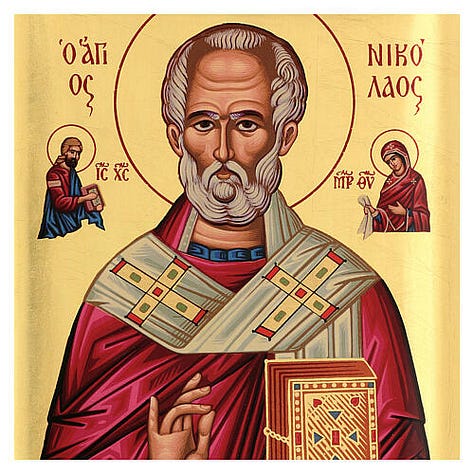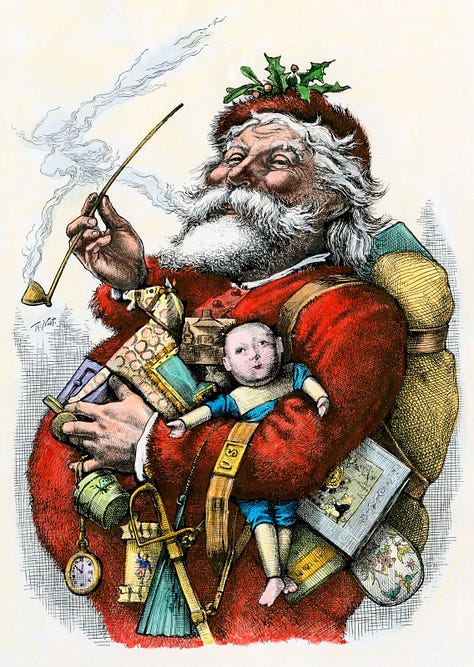How Saint Nicholas became Santa Claus
As Christmastime draws near, let’s take a look at one of the protagonists of the holiday season, Santa Claus, also known as “Jolly Old Saint Nick.” But how did Saint Nicholas go from 3rd century holy man to a large old man in a red suit who slides down a chimney to leave children gifts?



Nicholas was born to a devout Christian family around the year 270 AD in Patara, Lycia, located in modern-day Turkey. He lived during the reign of the Roman Emperor Diocletian, who was notorious for his severe persecution of Christians.
Nicholas’ parents died when he was still young, and they had left him a considerable inheritance. But rather than living a life of luxury, Nicholas took to heart the teachings of Jesus, especially the call to help the poor.
It was with this inherited wealth that Nicholas set off to help those in need. One of the more notable anecdotes was an incident with the poor man and his three daughters. Nicholas used his inheritance to provide the dowries for these young women, saving them from a bleak future of forced marriage or slavery.
Nicholas’s brave devotion to his faith and his acts of kindness didn’t go unnoticed by the local people, nor by the Romans. It’s said that he was eventually imprisoned and possibly tortured for his Christian beliefs during Diocletian’s persecution.
Nicholas was eventually released, and legend has it that he was present during the Council of Nicaea, convened by Emperor Constantine in 325 AD. This Council was a pivotal gathering in Christian history, aimed at addressing various disputes within the Church, most notably the Arian controversy over the nature of Christ’s divinity. During a heated debate at the council, Nicholas became so incensed by the views of Arius, a priest from Egypt who argued that Christ was not equal to God the Father, that he allegedly punched Arius in the face.
Nicholas’s death on December 6, 343 AD, became a celebrated feast day in many parts of the world - especially in Europe. In Italy, Saint Nicholas’ feast day is celebrated December 6th in the central and northern regions, while it is celebrated on May 9th in Puglia. Over time, he became a protector of children and sailors, and his legend grew, incorporating many miraculous events attributed to his intervention.
So how did this 3rd Century saint transition into a hefty man dressed in red who jumps down chimneys?
We have the Dutch to thank for modern Santa Claus! “Sinterklaas,” a shortened form of “Sint Nikolaas,” is an elderly and stately man, with a long white beard, a long, red cape, a bishop’s white alb and red mitre. He delivers gifts to children on the eve of December 6th, maintaining the tradition of the feast of Saint Nicholas. As the Dutch set out to establish new communities in the New World, they brought their Christmas traditions with them. But the Dutch weren't alone in shaping this iconic figure. Scandinavian immigrants, too, carried over their rich folklore, which mingled with the Dutch traditions.
The Scandinavians brought tales of Odin, a revered god in Norse mythology. Odin was honored during the Yule feast, a festive winter period that's the reason we still sometimes call the Christmas season "Yuletide." Alongside Odin's stories were those of a mischievous but good-hearted gnome known to the Danes, Swedes, and Norwegians as "tomte" or "nisse," depending on the region. This gnome played a role like Santa's, visiting homes during the winter solstice. The gnome would leave behind gifts for those who were well-behaved and mete out punishments for those who were not.
These cultural influences and traditions eventually merged and evolved over time, and the name was Anglicized to “Santa Claus.” And it was Clement Clarke Moore’s famous poem “A Visit from St. Nicholas (more commonly known as “The Night Before Christmas”)” in 1822 that solidified the image of Santa Claus as we know him today. The poem was printed in a local newspaper and soared in popularity.
Then, Thomas Nast, a political cartoonist, brought Moore’s poem to life in 1863 through his illustrations, drawing cartoons of Santa Claus with a bushy beard, red fur clothes, and smoking a pipe. From there on, this would become the standard image of Santa Claus known around the world.
So, although Santa Claus may bear little resemblance to the early Christian saint, the spirit of generosity and joy still prevails during this season, capturing the hearts of children and adults alike. And we will continue to explore the figure of Saint Nicholas and Santa Claus as they are interpreted throughout other cultures.
Sources:
History Makers: From Saint Nicholas to Santa Claus Overly Sarcastic Productions
“Sinterklaas vs. Santa Claus: What’s the Difference?” I Am Amsterdam
https://www.iamsterdam.com/en/whats-on/sinterklaas-v-santa-claus
“The Fascinating Folklore Origins of Santa Claus.” The Archive
https://explorethearchive.com/where-did-santa-claus-originate-from
“The Modern Santa Claus.” The International Santa Claus Hall of Famehttps://www.santaclaushall.com/history/the-modern-santa-claus/



